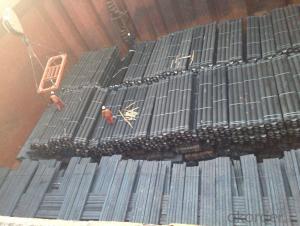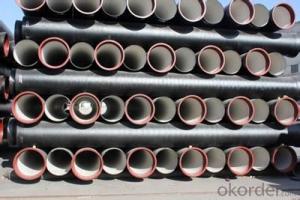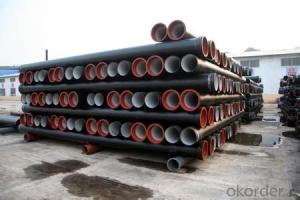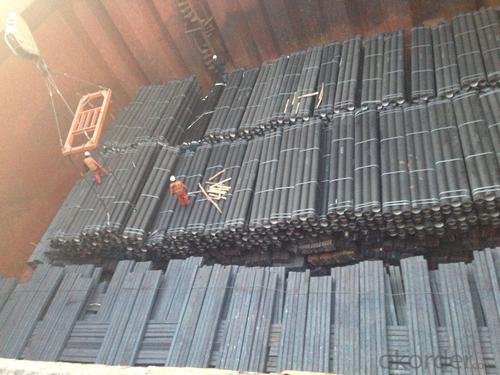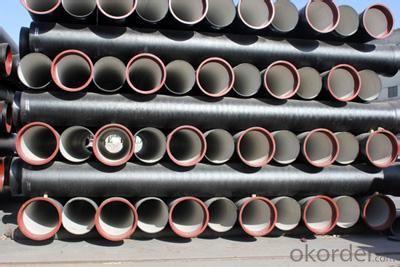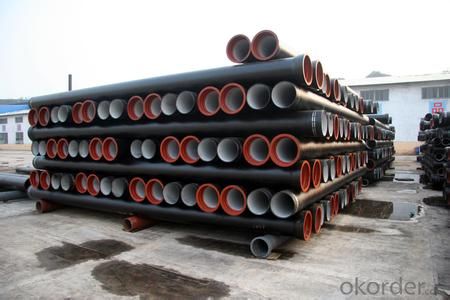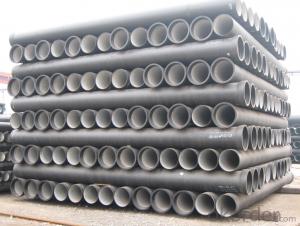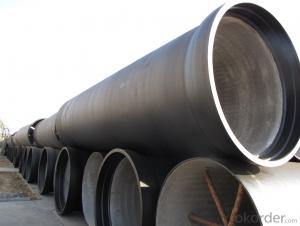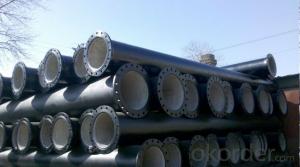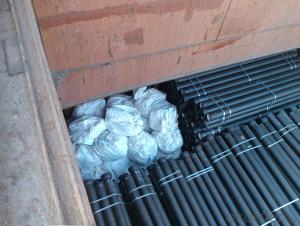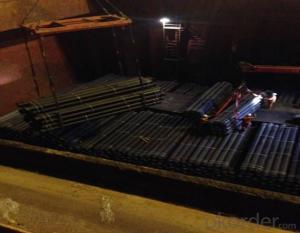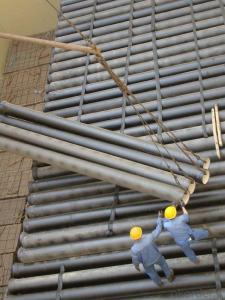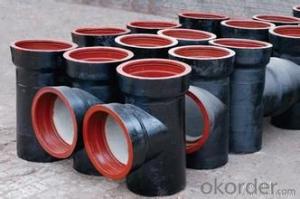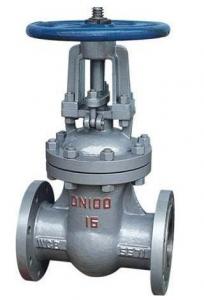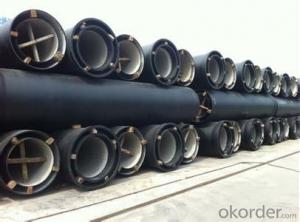DUCTILE IRON PIPE K9 DN450
- Loading Port:
- China Main Port
- Payment Terms:
- TT OR LC
- Min Order Qty:
- -
- Supply Capability:
- -
OKorder Service Pledge
OKorder Financial Service
You Might Also Like
Ductile Iron Cast Pipe is without any defects compare with tradition casting tech, which has many advantages particularly as follow:
(1) High density. In the "vertical upward casting" process, the melt iron of centre liquid column in center crystallizer is continuously feeding for volume shrinkage caused by condensation tube at outer circumference , which lead to be free of shrinkage porosity.
(2) High purity. When melt iron pouring, the mixed impurities such as gas, dross, sand grain which are lighter than melt iron could be eliminated at furnace mouth, its impossible to enter into the crystallizer through the channel, so the melt iron into the crystallizer is very pure.
(3) Strength with toughness. The cooling speed provided by continuous crystallizer is 30 times than sand casting and 5 times than centrifugal casting, and doesn't produce white iron, the eutectic cell volume of continuous cast iron is one eighth to one tenth compare with traditional cast iron. The density of graphite nodule in ductile iron can reach 300-700 pcs/mm2. Therefore, all reason above improve the strength and toughness of continuous cast iron.
(4) Free machining. The high speed cooling make the hardening phase (such as boride, steadite) not appear like reticular, massive or thick, but diffuse like fish bone and pane in shape, moreover, there are tiny graphite flakes inlaid hardening phase. It's free machining in BrinellHardness the range of 250-300HB. However, the Brinell Hardness of 250 is top limit to common metal materials.
(5) Uniform composition of tube wall. The convection mixing of liquid column caused by marching type drawing in crystallizer make the composition of tube wall well-distributed, and concentration gradient very little.
(6) High productivity. To the wall thickness of tube under 10mm, the speed of continuous casting is 1 meter/min, to the wall thickness of tube under 20mm, the speed of continuous casting is 0.5 meter/min, which is high efficiency that centrifugal or other casting tech couldn't reach.
- Q: Can ductile iron pipe be used for water supply to remote areas?
- Ductile iron pipe is indeed applicable for providing water supply to far-flung regions. Its exceptional strength and durability render it suitable for transmitting water over long distances. These pipes can endure high pressure and withstand external loads and impacts, making them an ideal choice for rough terrains and remote locations that pose challenges in terms of maintenance and repairs. Moreover, ductile iron pipes are equipped with a protective lining that prevents corrosion and guarantees the safety of the water for consumption. Consequently, ductile iron pipes prove to be an effective and dependable option for water supply to remote areas.
- Q: What are the typical surge anticipation measures for ductile iron pipe?
- Typical surge anticipation measures for ductile iron pipe involve implementing various techniques to mitigate the potential damage caused by surges or water hammer in the pipe system. These measures are designed to absorb or redirect the sudden pressure changes, preventing the pipe from rupturing or failing. Some common surge anticipation measures for ductile iron pipe include: 1. Air chambers: Air chambers are installed at strategic points along the pipeline to provide a cushion of air that absorbs the energy generated by surges. As the pressure wave travels through the pipe, the air compresses, reducing the impact on the pipe and minimizing the risk of damage. 2. Surge tanks: Surge tanks are large vessels connected to the pipeline that act as storage reservoirs for excess pressure. When a surge occurs, the surge tank absorbs the excess water volume, preventing it from causing damage to the pipe. The stored water is then gradually released back into the system, allowing pressure to stabilize. 3. Surge relief valves: Surge relief valves are installed in the pipeline to automatically release excess pressure during surge events. These valves open when the pressure exceeds a preset limit, allowing the surge to dissipate harmlessly. Surge relief valves can be adjusted to release the desired amount of pressure, ensuring the safety of the ductile iron pipe. 4. Water hammer arrestors: Water hammer arrestors are devices that absorb the shock generated by surges and water hammer in the pipe system. They consist of a sealed chamber with a compressible gas or liquid that absorbs the sudden pressure changes. By absorbing the energy, water hammer arrestors protect the ductile iron pipe from potential damage. 5. Surge suppressors: Surge suppressors are devices that regulate the flow of water during surge events. They are designed to reduce the speed at which surges travel through the pipe, minimizing the impact on the system. Surge suppressors can be installed at critical points in the pipeline to prevent damage to the ductile iron pipe. It is essential to consider the specific requirements of the pipeline system and consult with experienced engineers or industry professionals to determine the most suitable surge anticipation measures for ductile iron pipe installations.
- Q: Can ductile iron pipes be used in areas with high temperature variations?
- Ductile iron pipes are capable of being used in regions experiencing significant temperature fluctuations. These pipes possess exceptional thermal conductivity and can endure a wide range of temperature changes while maintaining their structural integrity. Their high coefficient of linear expansion enables them to adapt to temperature alterations without imposing substantial stress on the pipes. Consequently, ductile iron pipes are suitable for deployment in locales where extreme temperature variations, such as scorching summers and freezing winters, occur. Furthermore, these pipes exhibit remarkable resistance to thermal shock, enabling them to withstand abrupt temperature shifts without suffering cracks or breakages. In conclusion, ductile iron pipes are a dependable and long-lasting option for areas characterized by substantial temperature variations.
- Q: How much is the installation of cast iron pipe drainage 1 meters?
- Water supply pipe is the first choice, with high cost performance. Compared with the PE pipe, from the installation time, ductile pipe PE pipe installation is simple and rapid, and after the installation of internal and external bearing pressure better;
- Q: Can ductile iron pipes be used in contaminated groundwater systems?
- Yes, ductile iron pipes can be used in contaminated groundwater systems. Ductile iron pipes are known for their corrosion resistance, making them suitable for handling water with various levels of contamination. Additionally, their strength and durability allow them to withstand the harsh conditions of contaminated groundwater systems.
- Q: Are ductile iron pipes suitable for bridge piers or abutments?
- Yes, ductile iron pipes are suitable for bridge piers or abutments. Ductile iron is known for its high strength and durability, making it a reliable choice for supporting heavy loads in bridge construction. Additionally, ductile iron pipes are corrosion-resistant, which is crucial for structures exposed to moisture and environmental factors.
- Q: Are there any special coatings or linings available for ductile iron pipe?
- Indeed, there are specialized coatings and linings that can be utilized for ductile iron pipe. These coatings and linings are employed on either the internal or external surfaces of the pipe in order to safeguard against corrosion and prolong the pipe's lifespan. Cement mortar lining, polyethylene encasement, epoxy coating, and polyurethane lining are among the common coatings and linings utilized for ductile iron pipe. These coatings and linings are specifically designed to prevent corrosion when the pipe comes into contact with different substances such as water, chemicals, and soil. The choice of which coating or lining to use is dependent on the specific application and the environment in which the pipe will be installed.
- Q: Are ductile iron pipes suitable for wastewater treatment plants?
- Yes, ductile iron pipes are suitable for wastewater treatment plants. Ductile iron is a strong and durable material that is resistant to corrosion, making it an ideal choice for handling wastewater, which can contain various corrosive elements. Additionally, ductile iron pipes have high tensile strength and can withstand high pressure, which is necessary for transporting wastewater in a treatment plant. The flexibility of ductile iron pipes also allows for easy installation and maintenance, reducing the overall cost and time required for a wastewater treatment plant. Overall, ductile iron pipes are widely used in wastewater treatment plants due to their durability, corrosion resistance, and ability to handle the demanding conditions present in such facilities.
- Q: Can ductile iron pipes be used for underground chemical transport systems?
- Ductile iron pipes are commonly used for various applications due to their strength, durability, and resistance to corrosion. However, when it comes to underground chemical transport systems, there are certain factors that need to be considered before choosing ductile iron pipes as the suitable material. Firstly, the type of chemicals being transported should be evaluated. Ductile iron pipes are generally resistant to a wide range of chemicals, including acids, alkalis, and organic solvents. However, there are some chemicals that can corrode or react with the iron content of the pipes, leading to degradation and potential leakage. Therefore, it is crucial to assess the chemical compatibility and consult with chemical engineers or experts to determine whether ductile iron pipes are suitable for specific chemical transport applications. Secondly, the concentration and temperature of the chemicals should be taken into account. Elevated temperatures and high concentrations of certain chemicals can accelerate the corrosion process, potentially compromising the integrity of the pipes. It is essential to assess the operating conditions and ensure that the ductile iron pipes can withstand the chemical concentration and temperature levels. Additionally, the potential presence of abrasive or erosive chemicals should be considered. If the transported chemicals contain abrasive particles or have erosive properties, it may lead to increased wear and tear on the inner surface of the pipes, reducing their lifespan and potentially causing leaks. In such cases, alternative materials with higher resistance to abrasion or erosion may be more suitable. Lastly, it is important to comply with relevant regulations and standards. Different countries or regions may have specific requirements for underground chemical transport systems, including the choice of materials. It is necessary to ensure that ductile iron pipes meet the necessary standards and are approved for use in such applications. In conclusion, while ductile iron pipes have many desirable properties for various applications, including underground use, their suitability for chemical transport systems depends on several factors. Chemical compatibility, concentration and temperature levels, the presence of abrasive or erosive chemicals, and compliance with regulations should all be carefully evaluated before deciding to use ductile iron pipes for underground chemical transport systems. Consulting with experts in the field is highly recommended to ensure the safety and effectiveness of the chosen piping material.
- Q: How to properly maintain FRP pipes
- The wall of the pipe is smoothReduce flow resistance, increase flow speed and reduce energy consumption. Compared with the same size steel pipe, the flow rate of the same volume can be increased by about 10%, and no fouling and long-term use can not reduce the flow rate. The protection of cables in interference and heavy corrosion environment is better.
Send your message to us
DUCTILE IRON PIPE K9 DN450
- Loading Port:
- China Main Port
- Payment Terms:
- TT OR LC
- Min Order Qty:
- -
- Supply Capability:
- -
OKorder Service Pledge
OKorder Financial Service
Similar products
Hot products
Hot Searches
Related keywords
